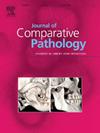免疫组织化学对猫皮肤圆细胞瘤的分化研究
IF 0.8
4区 农林科学
Q4 PATHOLOGY
引用次数: 0
摘要
50个猫皮肤圆形细胞肿瘤,包括一系列组织学诊断,暴露于大量的免疫组织化学标记,包括T淋巴细胞和B淋巴细胞、浆细胞、组织细胞、黑素细胞和肥大细胞,目的是提供物种特异性的标记模式信息。个别标志物在特定组织学类型的所有肿瘤中一致表达的情况很少。并非所有肥大细胞肿瘤都表达KIT,在一个黑色素细胞肿瘤中检测到KIT。高比例的浆细胞肿瘤共表达CD3和MUM-1,需要使用额外的免疫组织化学标记或特征来区分浆细胞肿瘤和t细胞淋巴瘤。b细胞淋巴瘤和浆细胞肿瘤中也有重叠的标记物表达。在一些组织细胞和黑素细胞肿瘤中检测到e -钙粘蛋白标记,而电离钙结合接头分子1标记的解释具有挑战性,因为许多肿瘤细胞群中含有大量肿瘤相关的巨噬细胞或树突状细胞。尽管有广泛的免疫组织化学标记,但仍有一部分病例无法确诊;然而,在大多数病例中,使用该小组可以得到更明确的诊断。本文章由计算机程序翻译,如有差异,请以英文原文为准。
Differentiation of feline cutaneous round cell tumours using immunohistochemistry
Fifty feline cutaneous round cell tumours, comprising a range of histological diagnoses, were exposed to a large panel of immunohistochemical markers for T and B lymphocytes, plasma cells, histiocytes, melanocytes and mast cells with the aim of providing species-specific information on labelling patterns. There were few instances in which an individual marker was consistently expressed in all tumours of a particular histological type. Not all mast cell tumours expressed KIT, and KIT was detected in one melanocytic neoplasm. A high proportion of plasma cell tumours co-expressed CD3 and MUM-1, necessitating the use of additional immunohistochemical markers or features to differentiate between plasma cell tumours and T-cell lymphomas. There was also overlapping marker expression by B-cell lymphomas and plasma cell tumours. E-cadherin labelling was detected in some histiocytic and melanocytic tumours, while interpretation of ionized calcium-binding adaptor molecule 1 labelling was challenging, with many tumours containing significant numbers of tumour-associated macrophages or dendritic cells alongside the neoplastic cell population. Despite the extensive panel of immunohistochemical markers, a proportion of the cases could not be definitively diagnosed; however, the use of this panel allowed for a more definitive diagnosis in most of these cases.
求助全文
通过发布文献求助,成功后即可免费获取论文全文。
去求助
来源期刊
CiteScore
1.60
自引率
0.00%
发文量
208
审稿时长
50 days
期刊介绍:
The Journal of Comparative Pathology is an International, English language, peer-reviewed journal which publishes full length articles, short papers and review articles of high scientific quality on all aspects of the pathology of the diseases of domesticated and other vertebrate animals.
Articles on human diseases are also included if they present features of special interest when viewed against the general background of vertebrate pathology.

 求助内容:
求助内容: 应助结果提醒方式:
应助结果提醒方式:


